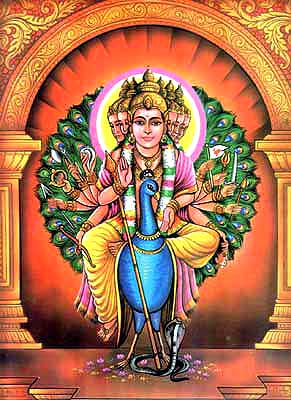|
| ||
Buddhist Traditions of Kataragama
by S. PathmanathanText extracted from Prof. Pathmanathan's paper "Guardian Deity of Lanka: Skanda-Murukan and Kataragama" presented at the First International Conference Seminar on Skanda-Murukan in Chennai, Dec. 28-30, 1998. This article first appeared in the September 1999 issue of The Journal of the Institute of Asian Studies. In the Buddhist tradition, Kataragama is one of the sixteen sacred sites in the island.21 One of oldest monastic centres in the country was established there. From pre-Christian times it was the seat of the rulers of a minor principality. The Ksatriyas of Kataragama, according to the Mahavamsa had joined Devanampiya Tissa of Anuradhapura in felicitating Sanghamita when she brought a branch of the sacred bo-tree. In relation to this event the Mahavamsa says: "The great thero Mahinda and the bhikkhuni Sanghamitta went thither with their following and the king also with his following. The nobles of Kajaragama and the nobles of Candanagama and the Brahman Tivakka and the people too who dwelt in the island came thither also by the power of the gods, (with minds) eagerly set upon the festival of the Bodhi tree."22 Tradition claims that "the ancient dageba called Kadidrali Vehera", which lies to the north of the Mahadevale, was built by Dutta Gamani. A sapling of the bodhi tree is said to have been planted at Kataragama during the time of Devanampiya Tissa in the third century BC because of the belief that the Buddha had visited the locality on his last visit to Lanka.23 The Mahavamsa records that the prince called Aggabodhi had built a vihara and a house for monks at Kataragama and renovated and enlarged another vihara, the one called Dhammasala, for which he granted the village called Mandagama.24 In the eleventh century, when the Colas were in control of the northern part of the island, Kataragama became the seat of local chieftains who held sway over parts of Rohana, one of the three traditional territorial divisions of the island. It would appear that the chieftain called Lokesvara had occupied Kataragama and exercised some control over Rohana. In connection with his exploits the Culavamsa says: "An army leader named Loka, who dwelt on Makkhudrusa, a trustworthy determined man capable of breaking down the arrogance of the Colas, after bringing the people over to his side took possession of the government in the district of Rohana and dwelt in Kajaragama versed in the conduct determined by custom."25 Later, the General Kassapa, who had the designation Kesadhatu, occupied Kataragama. During his time a Cola army had entered Kataragama but was soon repelled and in retreat it was purused beyond the frontier post of Rakkhapasana.26 Kassapa was dislodged from power by Kitti who later became king and assumed the name Vijayabahu.27 Skanda-Murukan entered the fold of Buddhism as one of the four guardian gods and it was in that capacity that he was established at the Kataragama devale which was originally attached to a Buddhist shrine that existed there. As there is no archaeological evidence of any kind at the site of the devale it is not possible to trace its origin and development before the fifteenth century. The shrine there was probably of very modest proportions and constructed with perishable materials. The inclusion of Skanda-Murukan into the company of the four-guardian gods and the provision for the accommodation of his devale within the premises of Buddhist temples seems to have resulted from the close interaction between Hinduism and Buddhism, which is exemplied at Kataragama in manifold ways. Skanda-Murukan as a deity was well known to the people of the island from pre-Christian times as suggested by the names Visakha and Kumara found in Brahmi inscriptions.28 The cult of Skanda seems to have exerted a strong influence on the royal court of Polonnaruva in the 11th and 12th centuries. The names Virabahu, Virapperumal and Parakramabahu which belonged to some of the princes suggest that Skanda was deeply venerated by members of the royal family.29 In fact Gajabahu II, as testified by an inscription, had conducted a laksapuja in honour of Skanda at the royal court and a certain Hinabi had made the image of the deity for this purpose. Skanda is referred to a guardian deity in inscriptions and chronicles since the 14th century. In one of the Lankatilaka inscriptions Upulvan, Saman, Vibhisana and Kantakumara are said to be the four god kings.30 The Lankatilaka and Gadaladeniya temples constructed during the mid-fourteenth century represent a distinctive phase in the development of Buddhism characterised by the assimilation Hindu influences and popular cults. The cult of the guardian gods became an integral part of Sinhalese Buddhism. Separate shrines dedicated to the guardian gods were accommodated in the architectural scheme of the temple and provision was made for conducting worship regularly at these shrines. Moreover, it is significant that in the imprecatory portions of royal grants the four guardian gods, namely, Upulvan, Saman, Vibhisana and Kanta-Kumara, are mentioned along with the triratna and the gods Mahesvara, Visnu and other gods as objects of veneration. The cult of Skanda became popular in the 15th and 16th centuries when several temples dedicated to him were established in the central and south-western parts of the country. The fact that Skanda came to be referred to as Kataragama Deviyo during the period of the Kantaiyan kingdom suggests that Kataragama was identified as the centre of his cult just as Devinuvara was in respect of Upulvan. Kataragama as the focal point of interaction between two religious traditions has a two-fold aspect. In the Buddhist perception the shrine at Kataragama is the shrine of Kanta-Kumara, one of the four guardian gods of Lanka whereas to the Hindus he is Skanda-Murukan, a manifestation of the omnipotent and transcendent Divinity. End Notes
See also:
|
| Living Heritage Trust ©2021 All Rights Reserved |